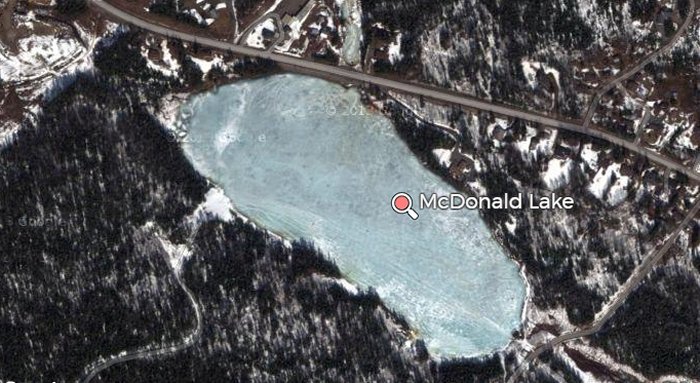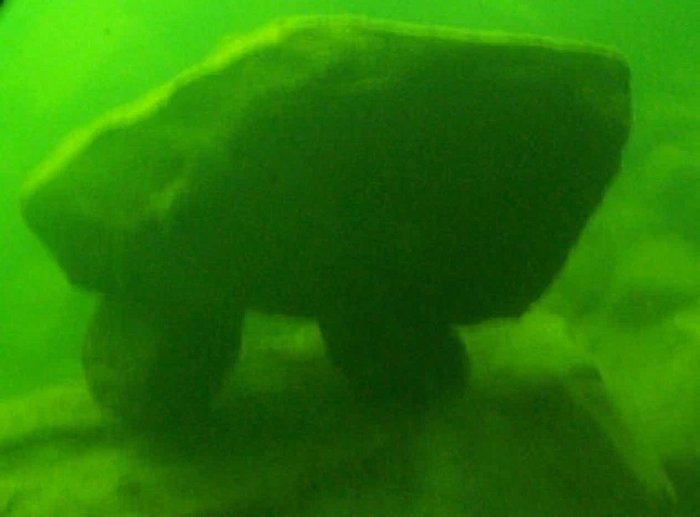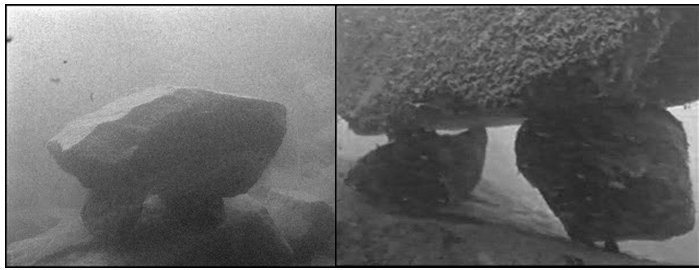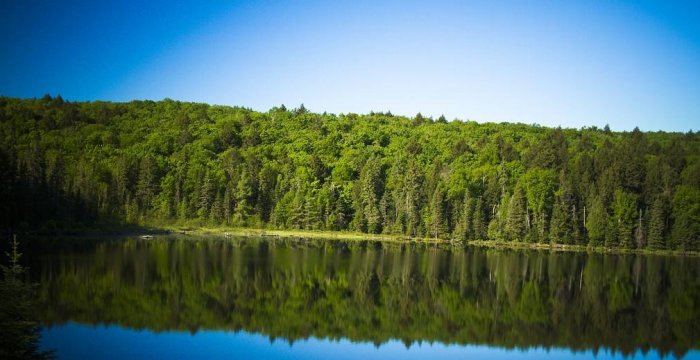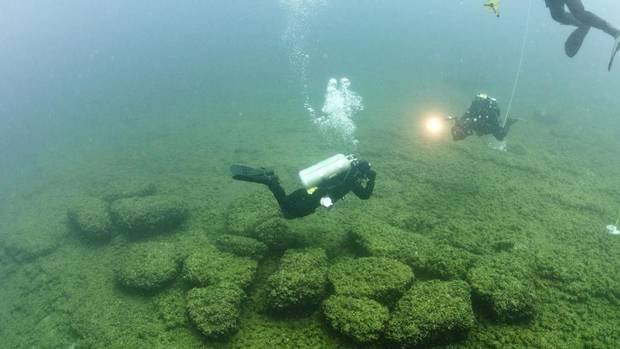Mysterious Ancient Underwater Structure Beneath MacDonald Lake Reveals Traces Of A Lost Civilization In Ontario
Ellen Lloyd - AncientPages.com - A mysterious ancient underwater structure hidden beneath MacDonald Lake reveals traces of a lost civilization present in Ontario, Canada thousands of years ago. Who were these people? Where did they come from and what happened to them? The discovery raises a number of unanswered questions.
The discovery was made by divers participating in a unique submarine project at the acclaimed Haliburton Forest and Wild Life Reserve. Haliburton Forest is a premiere Ontario attraction, well known for its commitment to education, wildlife and the environment.
At first, divers who examined the puzzling underwater structure thought it was a geological formation, but later studies it was a manmade object. The puzzling stone structure was found at a depth of 40 feet (12 m) below the surface. It consists of a massive 1,000 lb (453 kg) elongated rock with an almost completely level surface resting on 7 baseball-sized stones, which in turn sits on a huge several thousand-pound slab on top of a ledge.
Geologists and archaeologists were puzzled by ancient structure’s straight edges and lack of roundness. It seemed the stone could not be one of the rocks scoured by glaciers.
An underwater archaeologist who examined the structure took photos of the stone. He concluded that the existence of 3 shims was proof that the assembly of now seven rocks was the result of human activity and not a fluke of nature. Haliburton Forest turned to the services of a statistician to calculate the probability of 7 rocks falling on top of each other creating a "structure". Albeit difficult to assess, he reported back that even 4 rocks creating a natural structure was almost unattainable, but that the probability of 7 rocks hitting at the right time and place was virtually impossible.
Geologists and archaeologists examined the underwater structure beneath MacDonald Lake and concluded it's man-made.
So, if the underwater structure was not of natural origin, then it must be man-made, but who were its creators? When was the structure erected and for what purpose?
See also:
Man-Made Remarkable Underwater Structures Could Rewrite History Of Wisconsin
Divers continued to examine the mysterious underwater structure, searching for any signs of the use of tools, decorative images or other irregularities but found none of the kind. The thick layer of silt covering the vertical surfaces suggested that no human had touched the stone for a very long time.
There is geological evidence that Eastern North America experienced a dramatic drought between 9000 and 7000 BC. Conditions were so dry during that time that lake levels in the Great Lakes were up to 50 meters lower and inland lakes, like McDonald Lake, which were still fed by spring melt and summer rainwater, were assumed several dozen feet lower than their present water levels.
However, this does not answer the question of why during a time when so few people inhabited Ontario a small group would deliberately select remote MacDonald Lake for a stone cairn, especially such a large, elaborate one.
Biological data shows that McDonald Lake is home to an ancient, glacial relic lake trout, which had survived several bouts of glaciation and retained unique features, which allowed it to survive, where other fish had perished. This suggests that McDonald Lake, in prehistoric times was not a lake, but part and north-westerly end-point of an ancient river system which, for millennia, funneled glacial meltwater south into what was then mighty Lake Agassis.
The special environmental conditions the place had to offer in ancient times could have been the reason why our ancestors decided to live in the region.
Many questions still remain unanswered and perhaps we will never find the truth, but it doesn’t make the discovery less intriguing. There are several puzzling ancient man-made underwater structures discovered world-wide that show us there is still a lot we don’t know about our past. For example, archaeologists exploring Lake Huron, one of the five Great Lakes of North America have found traces of an ancient lost civilization that is twice as old as Stonehenge and the Great Pyramids of Egypt.
Traces of a civilization twice as old as the Stonehenge and the Great Pyramids have been discovered in Lake Huron.
A number of man-made remarkable underwater structures were also discovered in Wisconsin.
Beneath the waters of our oceans and lakes lie sunken buildings, roads, entire cities, pyramids and artifacts belonging to long lost and forgotten civilizations. In the near future, we will, without doubt, learn more about these amazing underwater structures that wait to be discovered and reveal their ancient secrets.
First version of this article was published on July 4, 2016.
Written by - Ellen Lloyd – AncientPages.com
Copyright © AncientPages.com All rights reserved. This material may not be published, broadcast, rewritten or redistributed in whole or part without the express written permission of AncientPages.com
More From Ancient Pages
-
 On This Day In History: Tsar Peter The Great Opens New Chapter in Russia’s History – On Mar 19, 1697
News | Mar 19, 2017
On This Day In History: Tsar Peter The Great Opens New Chapter in Russia’s History – On Mar 19, 1697
News | Mar 19, 2017 -
 Mythical Helen Of Troy: Beautiful Wife Of King Menelaus Of Sparta
Featured Stories | Jul 5, 2019
Mythical Helen Of Troy: Beautiful Wife Of King Menelaus Of Sparta
Featured Stories | Jul 5, 2019 -
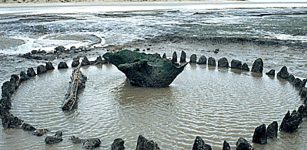 Remarkable 4,000-Year-Old Seahenge In Norfolk – What Was The Purpose Of The Bronze Age Monument?
Featured Stories | Jul 4, 2022
Remarkable 4,000-Year-Old Seahenge In Norfolk – What Was The Purpose Of The Bronze Age Monument?
Featured Stories | Jul 4, 2022 -
 Tiresias – Unusual Prophet Who Turned Into A Woman For Seven Years
Featured Stories | May 16, 2020
Tiresias – Unusual Prophet Who Turned Into A Woman For Seven Years
Featured Stories | May 16, 2020 -
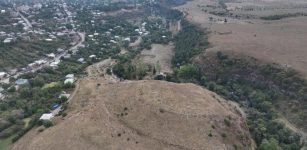 Why Was The Dmanisis Gora Fortress Community So Resilient In The Transition From The Bronze To Iron Age
Archaeology | Jun 5, 2023
Why Was The Dmanisis Gora Fortress Community So Resilient In The Transition From The Bronze To Iron Age
Archaeology | Jun 5, 2023 -
 Satellite Images Reveal A Mysterious Ancient Site On A Remote Island Is Much Larger Than Previously Thought, Prompting New Questions
Archaeology | Nov 28, 2024
Satellite Images Reveal A Mysterious Ancient Site On A Remote Island Is Much Larger Than Previously Thought, Prompting New Questions
Archaeology | Nov 28, 2024 -
 Tomb Of Maia, Tutankhamun’s Wet Nurse In Egypt’s Saqqara Opens To Public
Archaeology | Dec 22, 2015
Tomb Of Maia, Tutankhamun’s Wet Nurse In Egypt’s Saqqara Opens To Public
Archaeology | Dec 22, 2015 -
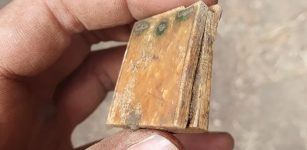 Extremely Rare And Tiny Medieval Sundial Discovered In Germany
Archaeology | Jul 31, 2023
Extremely Rare And Tiny Medieval Sundial Discovered In Germany
Archaeology | Jul 31, 2023 -
 Modern Humans Carrying The Neanderthal Variant Have Less Protection Against Oxidative Stress
Archaeology | Jan 6, 2022
Modern Humans Carrying The Neanderthal Variant Have Less Protection Against Oxidative Stress
Archaeology | Jan 6, 2022 -
 Mystery Of The Hidden Wooden Hieroglyphic Tablets And The Unknown White Bearded Men – The Civilization That Died Twice – Part 2
Ancient Mysteries | Mar 6, 2021
Mystery Of The Hidden Wooden Hieroglyphic Tablets And The Unknown White Bearded Men – The Civilization That Died Twice – Part 2
Ancient Mysteries | Mar 6, 2021 -
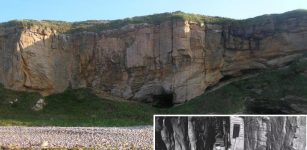 Mysterious And Frightening Sculptor’s Cave Of The Picts Reconstructed In 3D Model
Archaeology | Dec 10, 2017
Mysterious And Frightening Sculptor’s Cave Of The Picts Reconstructed In 3D Model
Archaeology | Dec 10, 2017 -
 Halicarnassus’ Monumental Tomb Built With Shining Stones Belonged To Carian Ruler Mausolus
Featured Stories | Jul 20, 2016
Halicarnassus’ Monumental Tomb Built With Shining Stones Belonged To Carian Ruler Mausolus
Featured Stories | Jul 20, 2016 -
 Stone Artifacts Reveal Humans Lived In Philippines 700,000 Years Ago – Much Earlier Than Previously Thought
Archaeology | May 11, 2018
Stone Artifacts Reveal Humans Lived In Philippines 700,000 Years Ago – Much Earlier Than Previously Thought
Archaeology | May 11, 2018 -
 Valuable Ancient Celtic Gold Coins Found By Birdwatcher – A War Chest For Queen Boudicca’s Campaign?
Archaeology | Jan 5, 2021
Valuable Ancient Celtic Gold Coins Found By Birdwatcher – A War Chest For Queen Boudicca’s Campaign?
Archaeology | Jan 5, 2021 -
 Huge 36-Million-Year-Old Skull Of Fearsome Marine Monster Discovered In Peru
Fossils | Mar 21, 2022
Huge 36-Million-Year-Old Skull Of Fearsome Marine Monster Discovered In Peru
Fossils | Mar 21, 2022 -
 On This Day In History: Battle Of Vincennes, Indiana – On Feb 24-25, 1779
News | Feb 24, 2017
On This Day In History: Battle Of Vincennes, Indiana – On Feb 24-25, 1779
News | Feb 24, 2017 -
 On This Day In History: Antonio Neri Was Born in Florence, Italy – On Feb 29, 1838
On This Day In History | Feb 29, 2020
On This Day In History: Antonio Neri Was Born in Florence, Italy – On Feb 29, 1838
On This Day In History | Feb 29, 2020 -
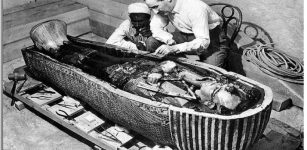 On This Day In History: King Tut’s Tomb Is Unsealed And Opened – On Feb 16,1923
News | Feb 16, 2017
On This Day In History: King Tut’s Tomb Is Unsealed And Opened – On Feb 16,1923
News | Feb 16, 2017 -
 Central European Prehistory Was Highly Dynamic – New Study Shows
Archaeology | Aug 27, 2021
Central European Prehistory Was Highly Dynamic – New Study Shows
Archaeology | Aug 27, 2021 -
 Thirsty Wheat Needed New Water Management Strategy In Ancient China
Archaeology | Nov 10, 2022
Thirsty Wheat Needed New Water Management Strategy In Ancient China
Archaeology | Nov 10, 2022

